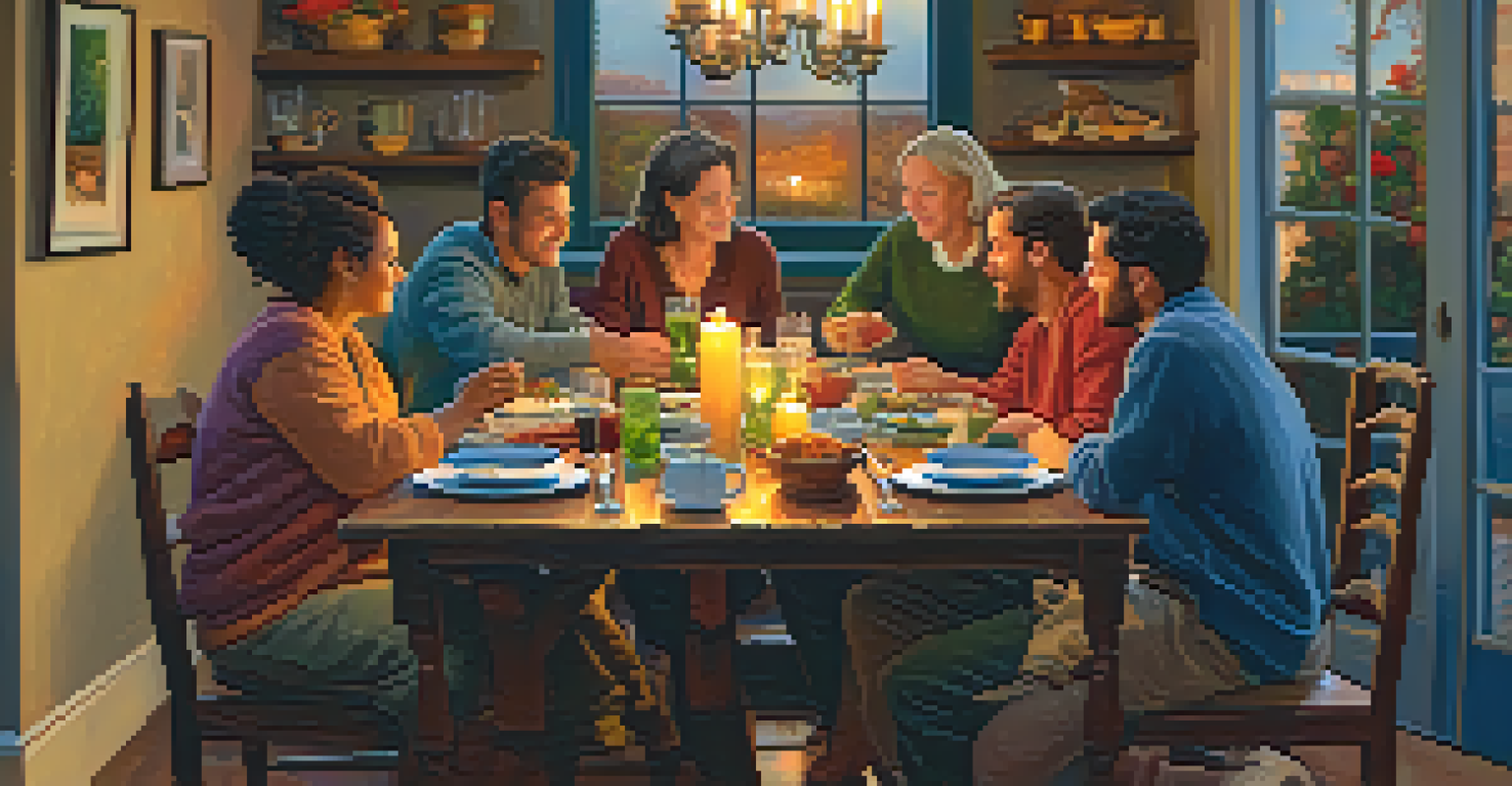The Role of Hallucinogens in Shaping Social Connections

Understanding Hallucinogens and Their Effects
Hallucinogens are substances that alter perception, mood, and cognitive processes. Common examples include LSD, psilocybin mushrooms, and mescaline. These substances can evoke vivid sensory experiences and deep introspection, often leading to altered states of consciousness.
The greatest gift of life is friendship, and I have received it.
While many view hallucinogens as purely recreational, their effects can lead to profound social interactions. Users often report feeling a heightened sense of empathy and connection with others during experiences. This unique perspective can reshape how individuals interact with their friends and communities.
The experience of sharing these altered states can foster a sense of community among users. Whether in a guided therapeutic session or a casual gathering, the bonds formed during such experiences can be deep and lasting, highlighting the social potential of these substances.
Historical Context of Hallucinogens in Social Settings
Throughout history, various cultures have utilized hallucinogens in rituals and community gatherings. For example, indigenous tribes in the Amazon have long used ayahuasca in ceremonies to promote social cohesion and spiritual connections. These practices underscore the long-standing recognition of hallucinogens as tools for enhancing social bonds.

In the 1960s, hallucinogens gained prominence in Western society, often associated with counterculture movements. Groups like the Merry Pranksters used LSD to foster communal experiences, emphasizing love and connection. This era highlighted the potential of these substances to challenge societal norms and create new forms of social interaction.
Hallucinogens Enhance Social Bonds
These substances often evoke a sense of empathy and connection, fostering deeper interactions among users.
Today, there's a growing interest in the therapeutic use of hallucinogens, particularly for mental health. As research continues to explore these benefits, we may see a resurgence of communal practices centered around hallucinogenic experiences, further shaping social connections.
Hallucinogens and Empathy: A Unique Connection
One of the most notable effects of hallucinogens is the enhancement of empathy. Users often report feeling more connected to the emotions and experiences of others, which can lead to deeper conversations and shared understanding. This heightened empathy can create a safe space for vulnerability among friends and acquaintances.
We are all connected; to each other, biologically. To the earth, chemically. To the rest of the universe, atomically.
For instance, during a psychedelic experience, individuals might discuss personal struggles or fears that they would normally keep hidden. This openness can strengthen relationships, as participants feel seen and heard in ways that everyday interactions may not allow. The shared experience of vulnerability can be transformative.
Moreover, this sense of connectedness can extend beyond individual relationships. Participants may feel a greater sense of responsibility toward their communities and the world at large, leading to collective actions aimed at social change. In this way, hallucinogens can act as a catalyst for both personal and social growth.
Psychedelics in Modern Therapy and Social Dynamics
The resurgence of interest in psychedelics for therapeutic purposes has opened new avenues for social connection. Clinical settings often create an environment where individuals share profound experiences that can enhance trust and camaraderie among participants. This therapeutic context fosters a unique form of social interaction.
Therapists who use hallucinogens in treatment often emphasize the importance of group dynamics. When individuals experience these substances together, they can form a support system that helps navigate the complexities of their emotions. This shared journey can lead to lasting friendships and deeper connections.
Historical Use in Community Rituals
Various cultures have historically utilized hallucinogens in rituals to strengthen social ties and promote cohesion.
As more studies highlight the benefits of psychedelics in therapy, we may see a shift in how society views these substances. By recognizing their potential to facilitate healing and connection, we can pave the way for more inclusive conversations around mental health and community support.
Building Community Through Shared Experiences
One of the most compelling aspects of hallucinogen use is its ability to foster community. When individuals come together to explore these substances, they often create a shared narrative that strengthens their bonds. This sense of belonging can be particularly valuable in an increasingly fragmented society.
Events like psychedelic retreats or festivals provide an opportunity for like-minded individuals to connect. Participants often engage in discussions about their experiences, leading to shared insights and personal growth. This communal aspect can transform how people view their relationships, fostering a sense of unity.
Moreover, these shared experiences can extend beyond the event itself. Participants often carry the lessons learned into their daily lives, positively impacting their relationships and communities. This ripple effect underscores the lasting influence of hallucinogens on social connections.
The Role of Intention in Social Interactions
Intention plays a crucial role in shaping how hallucinogens influence social connections. When individuals approach these substances with a clear purpose—such as fostering empathy or healing—they are more likely to experience meaningful interactions. This intentionality can guide the nature of conversations and relationships formed during the experience.
For instance, a group of friends might decide to use hallucinogens during a gathering to deepen their bonds. With the intention of exploring their emotions and vulnerabilities, they create a space where open dialogue can flourish. This proactive approach can lead to transformative experiences that strengthen their friendships.
Intention Shapes Experience Outcomes
Approaching hallucinogens with clear intentions can lead to meaningful social interactions and transformative experiences.
On the other hand, using hallucinogens without a clear intention may result in superficial interactions. Without the focus on connection, individuals may miss out on the opportunity to engage deeply with one another. Therefore, setting intentions before such experiences can significantly enhance the potential for meaningful social connections.
Navigating Challenges and Misconceptions
Despite the potential benefits, there are challenges and misconceptions surrounding the use of hallucinogens. Many people still associate these substances with negative stereotypes, focusing on the risks rather than the potential for positive social interactions. This stigma can hinder open conversations about their benefits.
Additionally, not every experience with hallucinogens is positive. Some individuals may face anxiety or discomfort, which can impact their social connections. It’s essential to approach these substances responsibly and be aware of one's mental state and environment to mitigate potential challenges.

By addressing these misconceptions and challenges, we can foster a more informed dialogue about hallucinogens and their role in shaping social connections. Encouraging responsible use and open conversations can help dismantle stigma and promote a deeper understanding of these substances' potential.